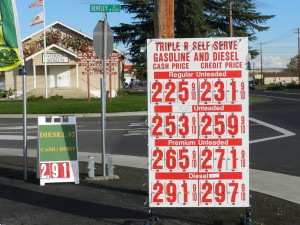
Many Valley citizens are rejoicing because gasoline prices have plummeted. When gas prices are low, the local economy picks up. If prices go back up, a bust may follow.
The Boom
A regular commuter from Manteca to San Jose told me that his travel time has varied by up to an hour depending on whether the economy is slow or booming. The better the economy, the longer the commute time.
When gas prices are low, people feel optimistic about the economy. Many forget that prices don’t stay low. They alter their behavior with short-term thinking.
The commute from the Valley to the Bay Area now appears more affordable. New home construction and resale of older homes will pick up as Bay Area residents leave their costly homes.
Furniture stores, realtors, and banks will record upticks in business as home sales increase. Pressure to take farm land for urban sprawl will increase.
The Bust
When gasoline prices rise, the boom economy will go bust, as it did in 1980, 1989, and 2008. In 1980, Modesto home prices melted down during a nationwide recession. Investors were wiped out. In 1989, the earthquake in the Bay Area resulted in a major economic downturn in the Valley. In 2008, the financial collapse that hit Wall Street preceded a catastrophic decline in Valley property values. Massive foreclosures, large drops in tax revenues, and cuts in public services resulted.
Given the lack of jobs in the Valley, commuters work in the Bay Area. When gasoline prices go up, many commuters are likely to move closer to their jobs.
This past decade, Modesto’s population was stagnant at just under 205,000. As people moved away to find jobs, they left vacant homes behind them. The glut of houses delayed new home construction, but planning has already begun for the next boom.
Each Bust Gets Bigger
As the urban areas in the Central Valley grow relentlessly during the booms, each subsequent bust gets bigger.
Agriculture is generally recession proof. Food is always in demand. Jobs in food production, harvesting and processing tend to be stable. But as each boom takes prime farm land for urban use, local food production is threatened by acreage loss.
In the past few decades, the number of cannery and food processing facilities in the northern San Joaquin Valley has dropped. As farmland prices rise because of urban encroachment, fruit production drops when farmers switch to more profitable crops or move elsewhere. Facilities close and operations are consolidated out of the area.
According to a local cannery supervisor, his facility processes less food every year. The work season is growing shorter as the amount of fruit coming in declines. The canning season is now so short that many workers don’t qualify for unemployment after layoff.
Jobs to Housing Imbalance Grows
The number of local jobs compared to the number of houses continues to move towards imbalance. When the imbalance grows, the unemployment rate rises. The Valley has an unemployment rate substantially higher than the rest of California. The local unemployment rate is sometimes double the state percentage.
Boom to Bust
As each boom brings temporary prosperity, everyone earning a living locally suffers the downturn when the bust comes. The experiences vary from loss of job to reduced pay due to lower business volumes to bankruptcy among those who did not plan for the inevitable downturn.
The magnitude of economic hardship endured by Valley citizens is much greater than reported. In recent years, the Valley has been referred to as “the Appalachia of the West.” As the peaks and valleys of the Valley’s economy become more exaggerated with each cycle, the misery index moves ever higher. If current gas prices encourage us to continue with business as usual, there’s even more misery is ahead.

Yes I agree with most of your article. As long as Valley cities are content with serving as bedrooms for the Bay Area, then true economic development that is lasting will be elusive.
As for the fruit (not nut) processors, the reduction in volume has much to do with growers switching from high risk fruit crops to lower risk nut crops. The net profit from tree fruit needs to be significantly more than with nuts to compensate for all the extra risks and the hassle of managing so much labor.